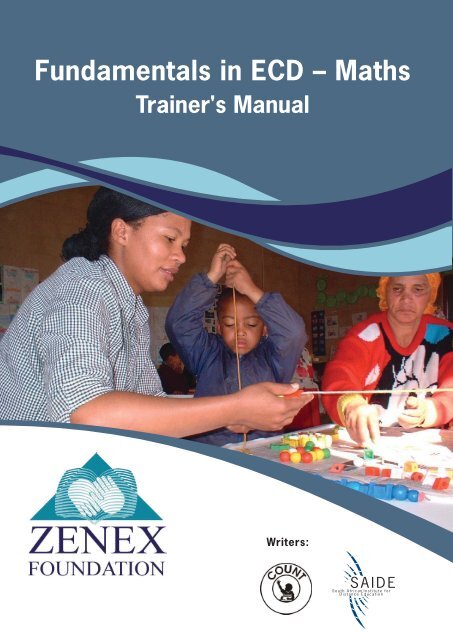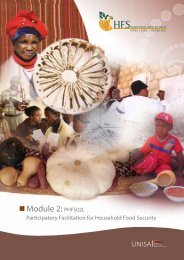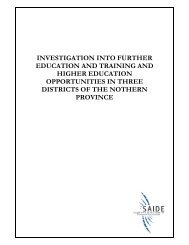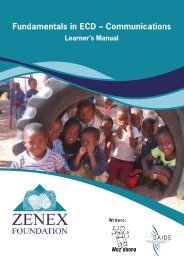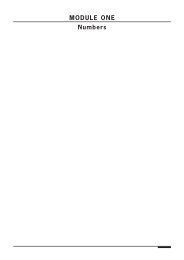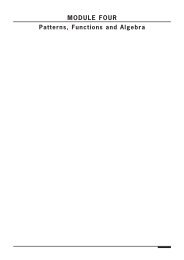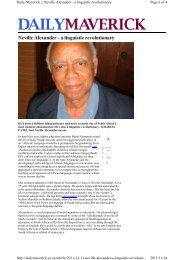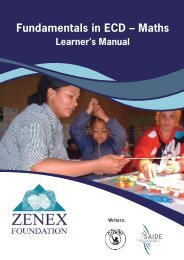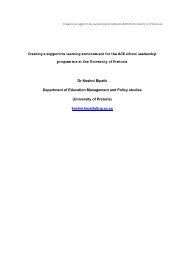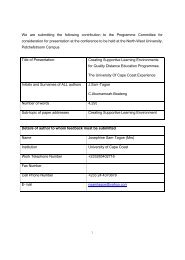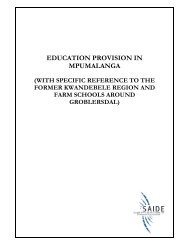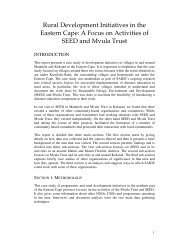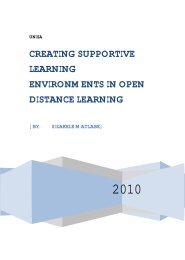Introduction - South African Institute for Distance Education
Introduction - South African Institute for Distance Education
Introduction - South African Institute for Distance Education
- No tags were found...
Create successful ePaper yourself
Turn your PDF publications into a flip-book with our unique Google optimized e-Paper software.
Fundamentals in ECD – MathsTrainer's ManualWriters:
Fundamentals in ECD : Mathematical Literacy Trainer’s Manual
Fundamentals in ECD:Mathematical LiteracyTrainer’s ManualWritersPenny Smith (COUNT), Victoria Lindsay, Aarnout Brombacher, Penny Hansen, Sheila DrewEditorIan Moll (SAIDE)<strong>South</strong> <strong>African</strong> <strong>Institute</strong> <strong>for</strong> <strong>Distance</strong> <strong>Education</strong>
ACKNOWLEDGEMENTSThese materials comprise both original text and sources from other published materialsthat have been used and adapted where necessary with permission <strong>for</strong>m the materialsdevelopers or publishers.COUNT wishes to acknowledge the following sources:Heinemann Publishers <strong>for</strong> permission to adapt selected activities from theirOUTCOMES MATHS series (no longer in print)Malati Public Domain Materials (funded by the Open Society Foundaiton)Ukuqonda Public Domain Materials produced <strong>for</strong> the Delta FoundationThe <strong>South</strong> <strong>African</strong> <strong>Institute</strong> of Race Relations <strong>for</strong> the use of graphs from the2004-5 SAIRR Survey.For artwork from Franco Frescura, Rural Shelter, (RAVAN PRESS) drawing of abeehive hut in Module 3, Activity 1.Problem Centred Mathematics <strong>for</strong> the use and adaptation of the following selectedactivities:Module 1Unit 6: Activity 7Unit 8: Activity 5-10Module 2Unit 8: Activity 2Module 3Unit 6: Activities 2-3Unit 7: Activities 2-7Unit 10: Activities 1-3Unit 11: Activity 9iii
Fundamentals in ECD : Mathematical LiteracyTrainer’s Manualiv
ContentsCONTENTS<strong>Introduction</strong>vi1. Who is this manual <strong>for</strong>? vi2. ECD Fundamentals vi3. Unit Standard Outcomes vii4. Language of learning vii5. The learning cycle viii6. How to use your Manual ix7. What you need x8. Assessment xi9. Using your journal <strong>for</strong> the first time xi10. Bantwana bami xiiiFundamentals Communication Unit Standards xiv1. Unit Standard 7451 xiv2. Unit Standard 7449 xv3. Unit Standard 7463 xvi4. Unit Standard 7453 xvii5. Unit Standard 7461 xviii6. Unit Standard 7450 xviii7. Unit Standard 7448 xiv8. Unit Standard 7447 xx9. Unit Standard 7464 xxiiv
Fundamentals in ECD : Mathematical LiteracyTrainer’s ManualINTRODUCTIONTrainer’s Note:This manual is <strong>for</strong> you, thetrainer. You will use it to trainECD practitioners at NQF LevelOne FundamentalsMathematical literacy. There isalso a Learner’s Manual whichyour learners will use. Thismanual is the same as theLearner’s Manual, except thatTrainer’s notes have beenadded. These notes will giveguidance and ideas on how tofacilitate the fundamentalscourse <strong>for</strong> your learners. Youwill identify the Trainer’s notesquickly because they are in abox headed ‘Trainer’s Note:’. Ofcourse, you need to read thisTrainer’s Manual be<strong>for</strong>ehand,and prepare yourself and yourresources well.Trainer’s Note:You need to plan yourworkshop time according tothis notional time. Butremember to take account ofwho your learners are. Manypeople need more time towork with mathematicalconcepts, especially if theyhaven’t worked withmathematics <strong>for</strong> a while. Sowhen you plan your time beprepared to be flexible andallow more time if necessary.1. Who is this manual <strong>for</strong>?This manual is <strong>for</strong> you, the ECD practitioner. You will use it to study <strong>for</strong>Fundamentals in Mathematical literacy at NQF Level One. It is written so thatyou can work through it alone, or with other early childhood practitioners in asmall study group, or in a workshop group with a trainer. Read the introductioncarefully alone or with your study group or trainer, to make sure you understandwhat you are doing. As you work through the activities you will slowly addressall the Unit Standard Outcomes <strong>for</strong> Fundamentals in Mathematical literacy.2. ECD FundamentalsFundamentals in Mathematical Literacy <strong>for</strong>m one part of a full ECD qualificationat Level One. For a full qualification you need to have 120 credits. These are madeup like this:ECD Core: 48 creditsECD Elective: 36 creditsFundamentals Communication: 20 creditsFundamentals Mathematical Literacy: 16 creditsYou can see that <strong>for</strong> Fundamentals Mathematical Literacy you need to get 16credits. That means that you should spend about 160 hours, or 20 days, studyingon this course. This time includes study outside of workshops such as onassignments and portfolio work. Remember that some people will need moretime, and others will not need as much.vi
<strong>Introduction</strong>Trainer’s Note:The Fundamentals UnitStandards <strong>for</strong> MathematicalLiteracy are currently underreview, and they may change.If they change you will see thatsome of the outcomes aredifferent. Some may be takenout and others added in, orexisting ones may be wordeddifferently. It is also possiblethat Unit Standard 7447 will beincluded in the qualification.This is another reason why weincluded it in this manual.Remember that the learners donot need to get credits <strong>for</strong> allthe unit standards. They onlyneed to get 16 creditsaltogether. At the moment thisdoes not include the 6 creditsfrom unit standard number7447. So when you plan yourtime you should add 60 hoursnotional time <strong>for</strong> the extra unitstandard. Even though it is notrequired <strong>for</strong> the qualificationwe recommend that you do itanyway.3. Unit Standard OutcomesThere are eight Unit Standards <strong>for</strong> Fundamentals Mathematical literacy. Theyshow what you need to be able to do (the specific outcomes) and how well youmust be able to do them (the Assessment Criteria). These are the unit standardscovered by this Manual:ID Unit Standard Title Level CreditsFundamentalsMathematical 7451 Collect, analyse, use and communicate Level 1 2literacynumerical data7449 Critically analyse how mathematics is used Level 1 2in social, political and economic relations7463 Describe and represent objects and the Level 1 2environment in terms of shape, space, timeand motion7453 Use algebraic notation, conventions and Level 1 3terminology to solve problems7461 Use maps to access and communicatein<strong>for</strong>mation concerning routes, location anddirection Level 1 17450 Work with measurement in a variety of contexts Level 1 27448 Work with patterns in various contexts Level 1 47464 Analyze cultural products as representations of Level 1 2shape, space and timeAdditional Unit 7447 Work with numbers in various contexts Level 1 6Standard notspecified <strong>for</strong>ECD Level OneQualificationCredits needed <strong>for</strong> Mathematical literacy (16)The last Unit Standard number 7447 is not required <strong>for</strong> a Level One ECDQualification, but we have addressed it in this course because we think it is veryhelpful and relevant to your work with children.We have included some sections which are not specified in the Unit Standards, <strong>for</strong>example the theorem on Pythagoras. We have included them because the UnitStandards are currently being reviewed, and we believe these sections may beincluded in the new Unit Standards.There is a list of all the Unit Standard Specific Outcomes and Assessment Criteriaon page xiv.vii
Fundamentals in ECD : Mathematical LiteracyTrainer’s ManualTrainer’s Note:Learners may find some wordsin this course difficult. We haveput a dictionary in the marginon each page. Encouragelearners all the time to addtheir own words to thedictionary.4. Language of learningThis manual is written in English. Maybe English is your second, or even thirdlanguage. You may need help with some of the English in this manual. You mightneed a dictionary, or perhaps you know someone who can translate some of thedifficult language <strong>for</strong> you.We have created a dictionary in the margin on each page. Add new words to thedictionary whenever you want to. Maybe studying will be easier if you are in agroup learning together with one Trainer. You can have discussions in homelanguages and ask <strong>for</strong> translations anytime. But we are assuming that you will beassessed in English.5. The learning cycleIn this manual you will see there are new ideas <strong>for</strong> you to read and think about.There are activities <strong>for</strong> you to do and there are opportunities <strong>for</strong> you to thinkabout what you have learned. Think of this as a learning cycle or learning path.It does not really matter where you begin in the cycle. You may begin with a newidea, do an activity, and then go back to the new idea be<strong>for</strong>e you think about whatyou have learned. You could also begin with an activity, look at new in<strong>for</strong>mationand then think about what you have learned. Good learning will always includeall three parts of the cycle. The learning cycle can be drawn like this:Trainer’s Note:Help practitioners tounderstand the link betweenthis cycle and how theEducator’s Manual has beenwritten. You can do this duringthe discussion about thefollowing icons.New Ideas /New ContentActivityWhat haveyou learned?viii
<strong>Introduction</strong>DICTIONARY:icon – small picture6. How to use your ManualStructureAll the way through the manual you will see the same cycle that you saw above.Each part of the cycle has an icon to show what it is:ActivityIn each activity you will do something, think about what you have done, anddiscuss or write down your thoughts. You can do most of the activities in yourManual unless you need more space. Sometimes the Manual will show that youhave to do an activity on a separate paper <strong>for</strong> your portfolio. There is a timeshown <strong>for</strong> each activity. This is only a guide because different learners may needdifferent amounts of time. It does not really matter how much time you spend, aslong as you find it meaningful, and you are sure that you understand.New ideas/contentOften there are some new ideas <strong>for</strong> you to read and think about be<strong>for</strong>e you do anactivity. This might be in<strong>for</strong>mation that you know already, or it might be newin<strong>for</strong>mation. These ideas will also prepare you <strong>for</strong> the activity.What have you learned?After activities there is writing that will help you to think about what you havelearned.There are other parts in the manual too. They also have icons. These are:CalculatorThere will be times when you need to use a calculator. This little icon will showyou when it is appropriate to use a calculator. There are other times when youmight want to use a calculator but it is better to do the calculations without thehelp of a calculator.Linking your learning to your ECD workWe want you to think about what you will teach children from what you havelearned in this course. This section in ach unit will help you to think about that.We believe that it is not good teaching practice to <strong>for</strong>ce ideas onto children. So donot go and simply teach them what you have learned. What you have learned isat the wrong level <strong>for</strong> young children. There will be times when children showinterest in something related to what you have learned. You can link thechildren’s interest to something you have learned here and work at the right levelwith children.ix
Fundamentals in ECD : Mathematical LiteracyTrainer’s ManualPortfolio WorkThis icon shows when it will be good <strong>for</strong> you to put activities or assignments intoyour portfolio <strong>for</strong> assessment.Self-assessment ChecklistYou can use the self-assessment checklist to check your progress against the listedoutcomes. They will also help your Trainer to keep track of how you are progressing.Using a JournalA journal is a book where you can reflect on your experience as a learner and asa teacher. There may be times when you feel worried about something. Then youcan write down your worries. You can write down tips and reminders to yourself.DICTIONARY:reflect on – think aboutNext to this icon you will always see a set of questions which will help you tothink about what to write. Answer these questions in your own words in yourjournal. Remember to put a date every time you write in your journal.The purpose of your journal is:• To make your ideas clearer to yourself by writing them down• To express your feelings about your learning• To keep track of your progress in your learning. This is another kind of selfassessment.You will keep a record of your understanding throughout thecourse. You can come back to something you have written in your journal andsee how your understanding has changed.• To practice writing without worrying about handwriting, grammar, spelling,correct order, paragraphs and other things. This will be very good <strong>for</strong> yourwriting skills, believe it or not.7. What you need• A punched exam pad <strong>for</strong> your exercises and assignments. You will file theseassignments in your portfolio• A file to keep your work safe and in order. File your work as you go along –don’t leave it to the last minute. This file will be your portfolio.• A pen or pencil• A dictionary. Some good dictionaries <strong>for</strong> this level are:SA Ox<strong>for</strong>d Dictionary <strong>for</strong> Adult LearnersPocket Ox<strong>for</strong>d DictionarySA Schools DictionaryMini DictionariesYou can buy these at any big branch of JUTA or CNA.• An exercise book to use as your journal• A calculatorYou may need other resources <strong>for</strong> some activities. These will be listed <strong>for</strong> you.x
<strong>Introduction</strong>Trainer’s Note:Be<strong>for</strong>e you train this course youneed to be sure that yourorganisation is accredited to trainfundamentals. You will have toapply to the ETDP SETA <strong>for</strong> thataccreditation. You will need to printthe letter and the materials fromthe Thutong website and sendthese with your application. Even ifyou are accredited you will stillneed to register all your learnerswith an accredited fundamentalsassessment agency such as IEB orUNISA. You will find their details inthe Assessment Guide at the backof this Trainer’s Manual.The assessment that you conductwith the learners on this course willbe <strong>for</strong>mative assessment, andpreparation <strong>for</strong> the summativeassessment.The Assessment Guide will guideyou and the learners through<strong>for</strong>mative assessment, throughpreparing a portfolio and throughpreparing <strong>for</strong> a summative exam.Remember that most learners willneed a lot of guidance on how tocompile a portfolio. That is part ofyour training responsibility.The activities are aligned with theFundamentals Unit Standards andcan be used as <strong>for</strong>mativeassessment. Some of the activitiescan be written separately or copiedand put into the portfolio.Assignments are all portfolio work.It would be a good idea to readyour Assessment Guide now.8. AssessmentYour trainer will provide you with a clear assessment guide. You must check thatyour trainer has arranged <strong>for</strong> you to be assessed by an accredited fundamentalsagency, like IEB or UNISA. If you are studying on your own or in a study groupmake sure you register with an assessment agency to be assessed. These are theonly organisations that can assess you and give you credits <strong>for</strong> your qualification.When you are assessed you will be assessed against the Unit Standard outcomes.Some of the activities can be used <strong>for</strong> assessment. These activities and all theassignments will go into your portfolio. You will see the Portfolio Work icon nextto these activities and assignments. In addition to your portfolio you will do anexam (test).Your Trainer will only do <strong>for</strong>mative assessment to help you prepare <strong>for</strong> the finalassessment. Formative assessment is not assessment <strong>for</strong> credit.What is a portfolio?A portfolio is a collection of your work that you show to a qualified assessor. Ofcourse, it should all be your own work, not copied. If your work is satisfactory,the portfolio will help to prove that you are competent in NQF1 Mathematicalliteracy. In this course your portfolio will contain:• Some activities• All your assignments• Your journal9. Using your journal <strong>for</strong> the first timeRemember the purpose of your journal is:• To make your ideas clearer to yourself by writing them down• To express your feelings about your learning• To keep track of your progress in your learning.In the next set of activities you will begin to write your journal. Do the activitiesin your journal.xi
Fundamentals in ECD : Mathematical LiteracyTrainer’s ManualActivity 1:Using your journal to learnTrainer’s Note:Time needed55 minutesThis set of activities is reallythe beginning of the learners’learning. They will be using ajournal all the way through thecourse, both <strong>for</strong> someactivities and <strong>for</strong> their ownreflection on their learning.You may want to have a breakhere, or do an icebreaker toset the tone <strong>for</strong> a shift inthinking.Write all these answers in your journal.1. Explain in writing what a journal is. Write in your home language. Use yourown words - don’t just translate directly from the explanation in this manual.2. Explain verbally what a journal is. Speak to somebody who speaks a languageother than English.3. Write down in your home language how you feel about writing a journal. Askyourself these questions:a. Have I done journal writing be<strong>for</strong>e?b. Am I still a bit worried about writing a journal?c. Is writing in my journal harder than I thought or easier?d. Do I usually worry about punctuation and spelling and grammar everytime I write?e. Did I manage to <strong>for</strong>get about grammar etc while I was writing in myjournal?4. Complete this sentence in English in your journal:For me, writing in my journal ………..Congratulations! You have just completed your first entry in your journal.Now do Activity 2.Activity 2:Writing a journal to suit the purposeTime needed40 minutesWork alone1. Look at the first writing activity in your journal and answer the followingquestions in writing in your journal:a. How will you know when you wrote in your journal?b. How will you know what activity you were writing about?c. Did you write full sentences? Are full sentences helpful?d. Would it help if you highlighted or underlined ideas, wrote them in colour,added arrows and numbers?e. Do you think you could draw some pictures in your journal?f. Discuss your answers with someone who is also using a journal.Remember your journal is not only to write down answers to questions, it is alsoa place <strong>for</strong> you to write down your feelings. Your feelings about your learning arenot right or wrong. It may take a little time to get used to writing your realfeelings. But often it is the best way to learn.xii
<strong>Introduction</strong>Linking using a journal with your ECD workThis is the first time in the course that you are going to think about how yourlearning links with your work as an ECD practitioner. These questions might helpyou to think about it some more:a. Can children keep a journal?b. How can children keep a journal if they cannot write? Are there other waysof recording thoughts and feelings?c. What kind of things do you think children can draw or write about?d. What do you think children can learn from keeping a journal?e. How do you think you can help children to understand what a journal is?f. How can you help children to write down their thoughts and feelings?g. Why is it useful <strong>for</strong> children to think about their feelings?There will be more opportunities <strong>for</strong> you to discuss these ideas later on in themanual. For now we want you to know that we think it is important <strong>for</strong> youngchildren to learn to reflect on their thoughts and feelings.10. Bantwana BamiFinally, let us introduce you to some of the characters you will meet in thismanual.Mrs Refiloe Maseko is the teacher and principal at Bantwana Bami home-basedday care centre. She has 18 children in her care and she uses her garage, a roomin her house and her yard to provide a space <strong>for</strong> the children to play and work.Mrs Maseko does the very best <strong>for</strong> her children. She makes sure she spends timechatting with them, reading to them, asking them questions and listening to them.Mrs Dlamini is a friend of Mrs Maseko. She runs an ECD centre in the nextvillage. They often sit together and chat about their work.xiii
Fundamentals in ECD : Mathematical LiteracyTrainer’s ManualFundamentals Mathemactical LiteracyUnit Standards1. Unit Standard 7451Collect, analyze, use and communicate numerical dataSpecific Outcomes and Assessment Criteria:SO1:Identify situations <strong>for</strong> investigation and data collection and collect numericaldata.1. Situations <strong>for</strong> data collection are identified in terms of the purpose <strong>for</strong> datacollection.2. Appropriate methods are selected to collect data.3. A variety of appropriate data collection methods are used to collect data fromprimary and secondary sources. (Surveys, books, interviews, observations,tally sheets and questionnaires.)4. The potential misuse of data achieved through the data collection method isdescribed.5. Reasons <strong>for</strong> and limitations of using sampling are described.SO2:Classify and analyze numerical data. (Grouped and ungrouped data.)1. Data is organized <strong>for</strong> meaningful analysis. (Classification, ordering, listing.)2. Analytical tools are used correctly and appropriately to analyze the data.(Median, mean, modes, frequency, range.3. The differences between and uses of mean, median and mode are described.SO3:Summarize and display organized numerical data. (Graphs: pie, frequencypolygon, histogram, simple bar graph, stem and leaf. Tables, basic tree diagrams.)1. The <strong>for</strong>m of display is appropriate to the data and context, and is justified interms of its appropriateness.2. The scale is selected and used <strong>for</strong> a reasonable presentation of the data, and thescale is justified in terms of its reasonableness.3. Different <strong>for</strong>ms of display are identified and evaluated in terms of theirpurposes.SO4:Extract, interpret and critically evaluate in<strong>for</strong>mation from various <strong>for</strong>ms ofdisplay. (Graphs: pie, frequency polygon, histogram, simple bar graph, stem andleaf. Tables, basic tree diagrams.)1. The in<strong>for</strong>mation extracted from the display is consistent with the display.2. The in<strong>for</strong>mation is interpreted to <strong>for</strong>m in<strong>for</strong>med opinions.3. Displays that distort in<strong>for</strong>mation are identified and the manner in which theydistort in<strong>for</strong>mation is described.4. The effect of distortions in displays is described in terms of the impact onmeaning in social, socio-historical, political and economic contexts.xiv
<strong>Introduction</strong>5. Projections or predictions are made in a manner that is consistent with thedisplay.6. The in<strong>for</strong>mation is analyzed to determine and report on the validity of datacollection methods, <strong>for</strong>ms of display and projections that are made.7. Communication of findings is clear, consistent with the display and makes useof accepted terminology.SO5:Demonstrate understanding of the concept of chance and calculate simpleprobabilities. (Limited to systematic counting strategies.)1. Situations are identified in which chance arises.2. Simple probabilities are determined.3. Statements of chance are correctly interpreted.4. The number of combinations and the probability of a particular event aredetermined.5. Probabilities are used to address simple real or simulated problems.2. Unit Standard 7449Critically analyze how mathematics is used in social, political and economicrelationsSpecific Outcomes and Assessment Criteria:SO1:Critically analyze the use of mathematical language and relationships in theworkplace. (Wage negotiations, salary increases, and productivity as a ratio.)1. The ways in which mathematics is used in the workplace are described.(Percentage, graphs, differences, ratio and proportion.)2. Ways in which mathematical relationships and language can be used torepresent particular perspectives are described. (Different <strong>for</strong>ms ofcomparisons such as differences versus ratio. Manipulation of graphs throughchoice of graph, scale of axes and nature of axes. Use of different averages:mean, median, mode. More than one perspective is to be described.)SO2:Critically analyze the use of mathematical language and relationships in theeconomy. (Budgeting, banks: interest rates, mortgage, service charges; fuel prices;pensions; inflation; value of the rand and exchange rates.)1. The ways in which mathematics is used is described. (%, graphs, differences,ratio and proportion.)2. Ways in which mathematical relationships and language can be used torepresent particular perspectives are described. (Different <strong>for</strong>ms ofcomparisons such as differences versus ratio. Manipulation of graphs throughchoice of graph, scale of axes and nature of axes. Use of different averages:mean, median, and mode. More than one perspective to be described.)3. The impact of economic changes on the individual is described.xv
Fundamentals in ECD : Mathematical LiteracyTrainer’s ManualSO3:Critically analyze the use of mathematics in social relations. (Socialdifferentiation: gender, social mobility, race; historical and possible futurecontexts, e.g. employment equity; apartheid policies.)1. Ways in which mathematics can be used as a filter <strong>for</strong> social differentiation aredescribed. (Social differentiation includes examples such as entrancequalifications; number of women doing mathematics.)2. The significance attached to number by different societies is described.(Spiritual; superstitious; aesthetic; political.)3. The use of mathematics in the media is described. (Adverts, reports, sports.)SO4:Critically analyze use of mathematics & mathematical language & relationshipsin political relations (Income distribution; census; elections; voting; opinionpolls.)1. The ways in which mathematics is used is described. (Percentage, graphs,differences, ratio and proportion.)2. Ways in which mathematical relationships and language can be used torepresent particular perspectives are described. (Different <strong>for</strong>ms ofcomparisons such as differences versus ratio. Manipulation of graphs throughchoice of graph, scale of axes and nature of axes. Use of different averages:mean, median, and mode. More than one perspective to be described.)3. The impact of the use of mathematics in these contexts on individuals andsocial groups is described.3. Unit Standard 7463Describe and represent objects and the environment in terms of shape, space, timeand motionSpecific Outcomes and Assessment Criteria:SO1:Describe and represent the position and change in position of an object in space.(Words, rough sketches and abstract representation on a Cartesian plane.)1. The positions of objects are described in relation to each other using graphsand sketches and written or verbal descriptions.2. The positions of objects are represented correctly on a Cartesian plane.3. The change of position of objects in terms of the relationship between spaceand time is described.4. Tessellations are identified.xvi
<strong>Introduction</strong>SO2:Illustrate changes in size & shape of appearance of objects as result of changes inorientation.1. The perception of the changes in an object is described from differentobservational points. (3-dimensional objects and 2-dimensionalrepresentations of 3-dimensional objects.)2. 3-dimensional objects are represented in 2 dimensions in such a way that thesize and shape of the object are correctly represented.3. The relationships between surface area and volume are described.4. Unit Standard 7453Use algebraic notation, conventions and terminology to solve problemsSpecific Outcomes and Assessment Criteria:SO1:Form and use algebraic equations and inequalities to represent and solveproblems. (Simple linear equations and inequalities.)1. The problem is represented completely through equations or inequalities,which are consistent with the problem.2. The concepts of equations and inequalities are explained.3. Situations requiring the use of equations as opposed to inequalities, and viceversa, are identified.4. Algebraic rotation, conventions and terminology are used correctly.5. The solution is correct in terms of the problem context.6. The solution is verified through substitution or other verification processes.SO2:Manipulate algebraic expressions to find equivalent <strong>for</strong>ms. (Common factors,products and grouping using associative, distributive and commutativeproperties.)1. The manipulated <strong>for</strong>m is equivalent to the original <strong>for</strong>m. (The originalexpression is manipulated to achieve at least two different <strong>for</strong>ms.)SO3:Select and use algebraic <strong>for</strong>mulae to solve problems. (Substitution into any<strong>for</strong>mula, solve <strong>for</strong> one variable, supplied <strong>for</strong>mulae from any context.)1. The correct <strong>for</strong>mula is selected in terms of the problem context.2. The <strong>for</strong>mula is applied correctly to obtain a valid solution.3. Units are used correctly.xvii
<strong>Introduction</strong>SO2:Use measuring instruments to measure and calculate quantities in variouscontexts. (Quantities include all of: length, distance, mass, time, temperature,volumes of regular prisms, perimeter, area, weight, surface area, density,displacement and angles. Measuring instruments include all of: rulers, tapemeasures, scale, clocks, thermometers, capacity measuring instruments, andprotractors.)1. Measuring instruments are used correctly.2. Readings are recorded and reported within the margin of error as limited bythe instrument and as is appropriate within the context.3. Measuring instruments are chosen to comply with the accuracy requirementsof the context.SO3:Solve measurement problems in various contexts. (Practical and non-practicalprocesses, trigonometric right-angled heights and distances.)1. Solutions are correct within margins of error allowed within the context.2. Units are used correctly.3. Methods and solutions are justified.7. Unit Standard 7448Work with patterns in various contextsSpecific Outcomes and Assessment Criteria:SO1:Recognize, identify and describe patterns in various contexts. (Numeric,geometric, patterns from a variety of contexts.)1. Patterns are recognized in terms of the relationship between the elements ofthe pattern.2. Patterns are correctly identified in terms of the relationship between theelements of the pattern.3. Patterns are correctly described in terms of the relationship between theelements of the pattern and remain consistent through the pattern.4. The language of comparison is appropriate and describes the relationshipbetween the elements of the pattern.SO2:Complete, extend and generate patterns in a variety of contexts. (Numeric,geometric, patterns from a variety of contexts.)1. Completed patterns are internally consistent with respect to the relationshipbetween elements of the pattern.2. The extension is consistent with respect to the relationship between elementsof the pattern.3. Generated patterns are internally consistent.xix
Fundamentals in ECD : Mathematical LiteracyTrainer’s ManualSO3:Devise processes <strong>for</strong> a general rule. (Processes include: systematic counting,sequencing numbers, tables, drawings, pictures, classification, organized lists,mathematical and models such as graphs.)1. Appropriate processes are devised according to the context.2. Processes have potential to lead to a general rule.3. A general rule is devised such that it is consistent with the relationship of theelements of the patterns.SO4:Represent patterns using different generalized mathematical <strong>for</strong>ms. (Graphs,<strong>for</strong>mulae, expressions and other rules <strong>for</strong> expressing patterns.)1. Appropriate mathematical <strong>for</strong>ms are used to represent patterns.2. The representation is consistent with relationships within the pattern andrepresents the pattern completely.3. Conversions are made between various <strong>for</strong>ms of representations.4. Relationships between various possible <strong>for</strong>ms of representations aredescribed.SO5:Use general rules to generate patterns. (Processes include: systematic counting,sequencing numbers, tables, drawings, pictures, classification, organized lists,mathematical models such as graphs.)1. Patterns generated are consistent with the general rule.2. Patterns are generated to the extent that they enable the rule to be devisedfrom the pattern.8. Unit Standard 7447Working with numbers in various contextsSpecific Outcomes and Assessment Criteria:SO1:Express and interpret a range of contexts using mathematical symbols and findapplications <strong>for</strong> numerical models. (Everyday problems, numerical contexts.Numerical models include equations, expressions and terms.)1. Mathematical sentences reflect the situation completely and accurately.(Everyday problems, numerical contexts. Numerical models includeequations, expressions and terms.)2. The <strong>for</strong>m of expression is appropriate to the context.3. Application <strong>for</strong> given numerical models are developed such that the meaningof symbols and relationships between them are clarified.xx
<strong>Introduction</strong>SO2:Solve a range of everyday problems using estimation and calculations. (Roundingoff and truncating, with or without calculator, combination, separation,comparison, equalisation, sharing and grouping.)1. Problem solving strategies are based on a correct interpretation of the problemsituation.2. Estimates can be justified within context.3. Calculations are per<strong>for</strong>med accurately.4. Calculations follow some <strong>for</strong>m of logical reasoning process, which ispresented clearly.5. Solutions are correct in terms of the context.SO3:Verify and justify solutions within different contexts. (Solutions derived bylearners and by others.)1. The reasoning process is explained clearly.2. Solutions are justified in terms of the context. (Appropriate and inappropriatesolutions.)3. Solutions are shown to be consistent with estimations and vice versa.SO4:Per<strong>for</strong>m operations on simple and complex numerical expressions. (Four basicoperations in all combinations. Expressions involving exponents that can becalculated without a calculator. Operations to be per<strong>for</strong>med with and without acalculator.)1. Operations are per<strong>for</strong>med according to the conventions governing the order ofoperations.2. Solutions are correct.SO5:Describe and compare counting systems from different cultures. (Own, <strong>African</strong>culture other than own, one other.)1. Numbers are translated from one base system to another. (Base 2, 5, 10, and16.)2. Descriptions show understanding of how counting systems developed andtheir significance.3. Descriptions show examples of how the systems might have been used, andthe limitations of the system.xxi
Fundamentals in ECD : Mathematical LiteracyTrainer’s ManualSO6:Critically analyze the development of the base ten number system. (Place value,role of 0 in our number system, patterned nature of whole numbers, history andcontestations.)1. The development and significance of zero is explained.2. Understanding of the place value of numbers is demonstrated. (Expansion ofnumbers in different ways, the value of a numerical symbol in a number.)3. The patterned nature of whole numbers and its historical development aredescribed.4. The contestations around, and use and popularisation of the decimal numbersystem are described. (Uses in economics and politics.)SO7:Analyze the relationship between rational and whole numbers.1. Demonstrations describe the increasing density of the system.2. Demonstrations show that whole numbers are a subset of rational numbers.3. The properties of whole numbers and rational numbers are given.SO8:Analyze the relationship between rational numbers and integers.1. Demonstrations describe the increasing density of the system.2. Demonstrations show that whole numbers are a subset of rational numbers.3. The properties of whole numbers and rational numbers are given.9. Unit Standard 7464SO1Identify geometric shapes and patterns in cultural products. (shapes of anddecorations on cultural products such as drums, pots, mats, buildings, andnecklaces.)1. Basic trans<strong>for</strong>mations are identified. (translations, reflections and rotations.)2. Basic geometric shapes are identified.3. Basic patterns are identified and described.4. Basic patterns are extended in a way that maintains the consistency of thepattern.xxii
<strong>Introduction</strong>SO2Analyze similarities & differences in shapes & patterns, & effect of colour, used bycultures. (analyze similarities and differences in shapes and patterns, and theeffect of colour, used by different cultures.)1. Similarities in shapes and patterns are identified.2. Differences in shapes and patterns are identified.3. Possible reasons <strong>for</strong> similarities and/or differences in shapes and patternsused by different cultures are identified.4. The effect of colour on shape and symmetry is described and illustrated.SO3Analyze and explain the way shapes and space are used in different epochs andcultures. (Architecture, town and settlement planning.)1. Shapes used by different cultures are identified.2. The use of space in different cultures is analyzed and explained.3. The use of space in different epochs is analyzed.xxiii


